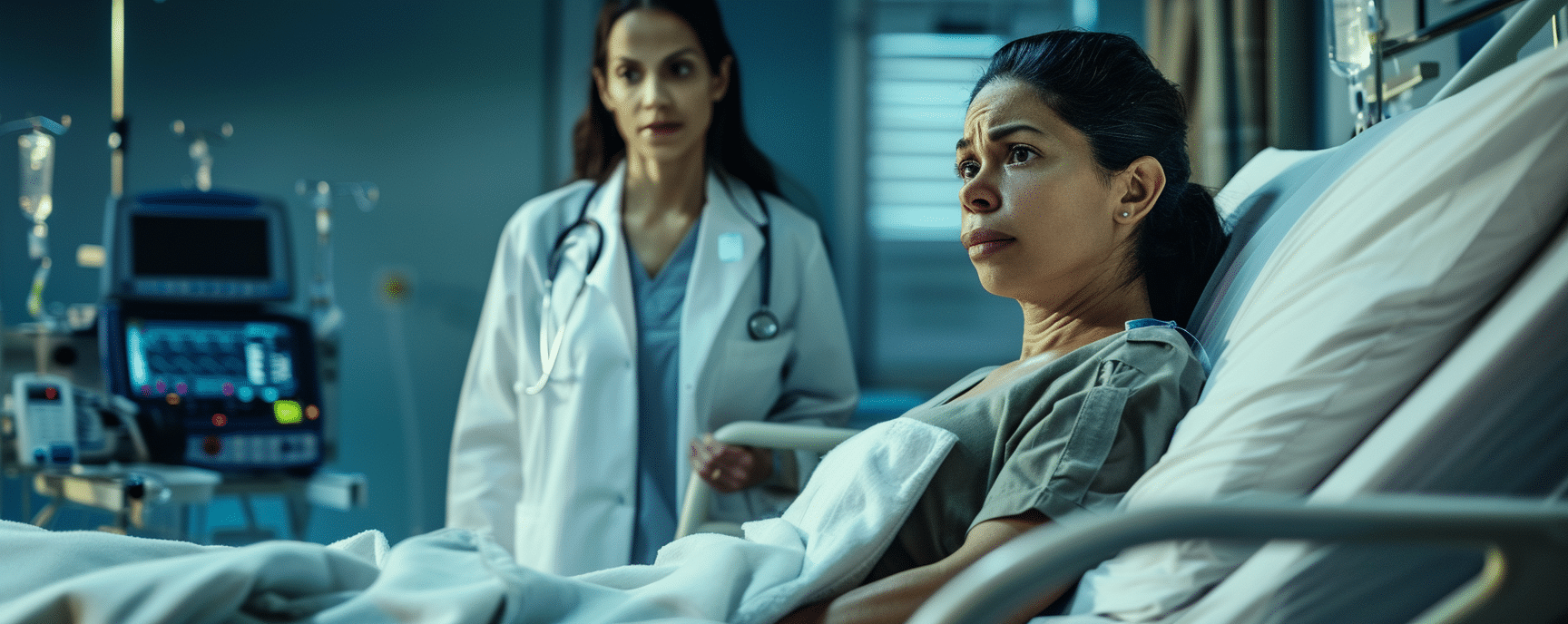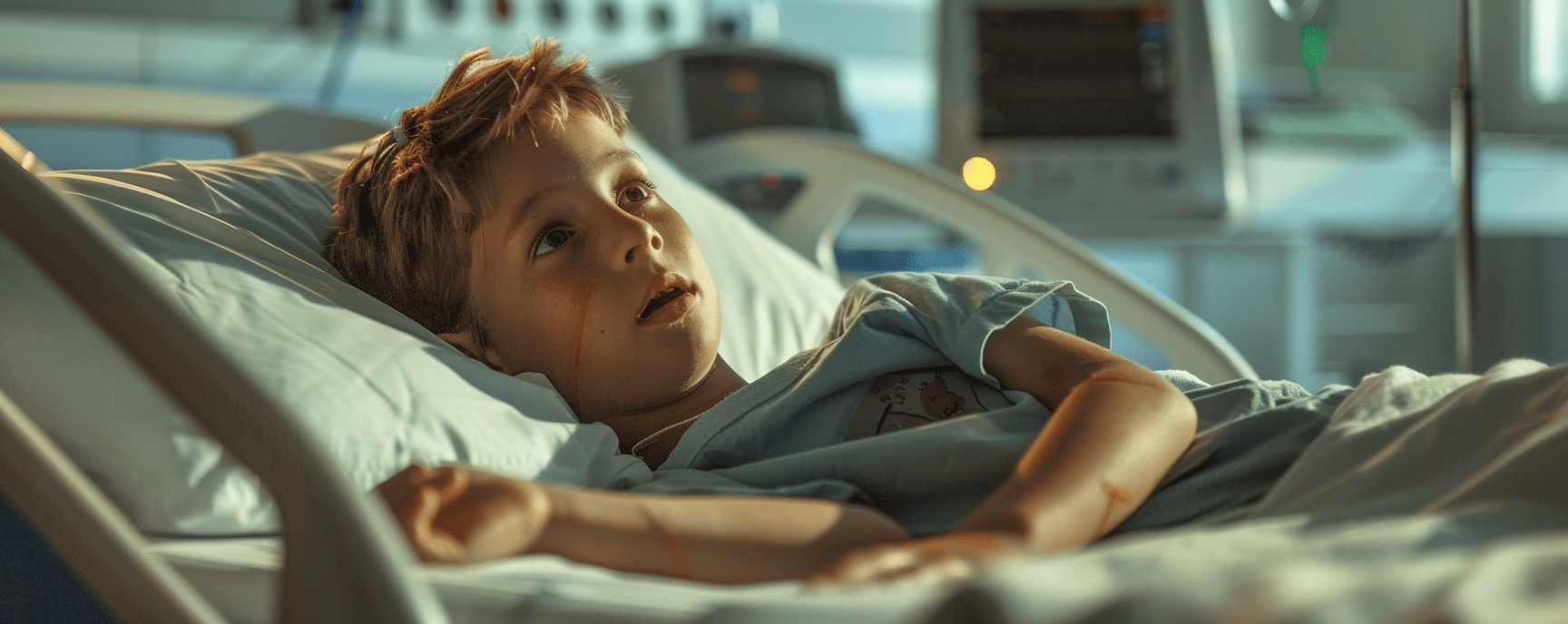Key Takeaways
- Bike crash injury severity is influenced by various factors including speed, age, and the involvement of motor vehicles, with high-speed collisions and alcohol involvement exacerbating the risk of severe head and other injuries.
- Proper usage of protective gear, especially helmets, can significantly reduce the risk of head, brain, and severe brain injuries in cycling accidents, highlighting the importance of wearing and maintaining appropriate safety equipment.
- Legal recourse following bike accidents is vital for compensation and recovery, and seeking specialized legal counsel can aid in navigating the complexities of personal injury claims and achieving fair settlements.
Let's Go Beyond, to Bring You Back
Let's get you the compensation you're entitled to. Get a FREE Consultation today.
Let's Go Beyond, to Bring You Back
You deserve the compensation you’re entitled to, call for your FREE Case Review today.
Understanding the Severity of Bike Crashes
There’s a deceptive simplicity to the concept of a bike crash. After all, how severe can a collision be when you’re only powered by your own two legs? Sadly, the reality is far more complex. It’s not just about scrapes and bruises; a bike crash can result in profound health issues that ripple outwards, impacting every facet of life.
Considerations of speed, age, and the involvement of motor vehicles all contribute to the severity of injuries. For instance, research indicates that higher estimated impact speeds are directly correlated with more severe injuries in bike accidents. Similarly, the severity of injuries can be higher in older cyclists when involved in bicycle accidents. This underscores the need for all cyclists, including injured cyclists, to exercise caution and vigilance while on the road.
High-Speed Collisions: A Recipe for Disaster
The allure of speed is undeniable for many cyclists. The thrill of the wind in your face, the exhilaration of the blur of scenery rushing past—it’s a siren call that many find irresistible. But this need for speed can come at a heavy cost. Higher impact speeds in collisions between bikes and cars are correlated with more severe injuries.
High-speed collisions significantly increase the likelihood of severe head and facial injuries. The statistics are stark reminders of the danger, with fatalities and severe injuries all too common in high-speed crashes. It’s a sobering thought that something as simple as the need for speed can transform a leisurely bike ride into a life-altering event.
The Role of Motor Vehicles in Traumatic Bicycle Accidents
While cyclists must always be vigilant of their own actions, they are not the only road users that contribute to the severity of bicycle accidents. Motor vehicles play a pivotal role in traumatic bicycle accidents. Intersection-related situations are the most common scenarios for bicycle and car collisions, with over 75% happening there, often even in intersections marked with bike lanes. In 2021, the majority of fatal bicycle collisions involved major roads other than interstates and freeways, representing 65% of bicyclist deaths.
The role of alcohol in bike crashes cannot be ignored either. According to data from 2021, 19% of bicyclists aged 16 and older who were killed had blood alcohol concentrations at or above the legal limit. These sobering facts underscore the role of motor vehicles and alcohol in the severity of bike accidents and highlight the importance of prevention and awareness.
Protective Gear: Can Helmets and Pads Make a Difference?
As cyclists, we can’t control every aspect of our environment, but we can control how we prepare for it. Protective gear, like helmets and pads, can be literal lifesavers in the event of a crash. Helmets significantly reduce the risk of head, brain, and severe brain injuries in crashes involving motor vehicles by 69%. They also lower the incidence of serious head and facial injuries in cycling crashes, not just those involving motor vehicles.
But it’s not enough to just wear a helmet; it needs to be the right helmet and it needs to be worn correctly. Helmets should be replaced after a significant impact or at least every five years due to material degradation. After all, a helmet can only protect you if it’s in good condition and fits properly.
Houston Bicycle Accident Lawyer
Get Compensated For Your Injuries & Damages! Call Us For A FREE Case Review And Know What Your Case Is Worth.
Anatomy of Catastrophic Bike Accidents
As we delve deeper into the world of bike accidents, it becomes clear that the issue is a complex tapestry of factors. Understanding where and how catastrophic bike accidents occur is crucial for implementing effective safety measures. Intersections are significant sites for catastrophic bike accidents. In 2021, 35% of bicyclist deaths were reported to have taken place at intersections. The consequences of intersection-related accidents are often severe due to factors like multiple traffic lines, turning vehicles, and possible high speeds.
This data is not intended to alarm but to educate. By understanding the anatomy of these accidents, we can better prepare for them and hopefully prevent them. Let’s explore some of the most common types of catastrophic bike accidents and how they can be prevented.
Head-On Collisions: Facing the Worst Impact
Few accidents are as terrifying as a head-on collision. These accidents can result in a variety of head injuries, including mild head injuries, with different impact speeds, angles, locations, and surfaces involved. A helmet offers considerable protection against skull fractures and focal brain pathologies but is less effective in reducing diffuse brain injuries.
The face is often not well protected by conventional bicycle helmets, leaving it vulnerable in head-on collisions. Head impact speeds in collisions can range from 5 to 16 meters per second, with higher speeds typically involving another vehicle. The majority of head impacts in bike accidents occur against flat surfaces and common impact regions include the side and front of the head, with a notable number of occipital impacts.
Side Impacts and Dooring: When Bicycles Meet Unseen Hazards
While head-on collisions are certainly terrifying, side impacts and dooring accidents present their own unique dangers. Dooring accidents happen when a driver opens their car door without checking for passing cyclists, leading to potential collisions. The consequences can be severe, including being thrown into traffic or sustaining road rash from falls onto the pavement.
Side-sweeping accidents can occur on busy highways when motorists do not provide sufficient space for bicyclists, forcing the cyclists into dangerous proximity with vehicles. Both of these types of accidents highlight the importance of awareness and caution on the part of both cyclists and motorists.
Rear-End Crashes: The Unseen Threat from Behind
The danger isn’t always in front of us. Sometimes, the threat comes from behind. Rear-end collisions pose a significant risk to cyclists, particularly when drivers misjudge the distance to a bicycle and follow too closely, especially if the cyclist stops suddenly. When a rear-end bicycle accident occurs, the cyclist can be thrust forward, resulting in severe injuries upon contact with the vehicle, the pavement, or both.
Although intersection-related crashes are more common, rear-end and sideswipe collisions still represent significant causes of bicycle accidents with vehicles, necessitating awareness and preventative measures. These accidents serve as a stark reminder that cyclists need to be constantly aware of their surroundings, even what’s behind them.
Traumatic Brain Injuries: The Invisible Aftermath
While the physical scars of a bike accident can be shocking, the invisible wounds can be even more devastating. Traumatic brain injury resulting from severe bicycle accidents can lead to a wide range of outcomes, from rapid recovery to long-term or permanent disabilities, deeply impacting the individual’s quality of life. In fact, bicycle accident-related brain injuries typically occur when the cyclist’s head strikes the ground or another object, potentially causing bruises, torn brain tissue, and other forms of brain damage.
Medical treatments for bicycle accident-induced brain injuries may involve:
- Surgery
- Various therapies
- Cognitive rehabilitation
- Pharmacologic management
It’s a daunting prospect, but understanding the potential aftermath of a bike accident can equip us with the knowledge and tools needed to navigate the healing process.
Concussion: The Mild but Deceptive Enemy
Among the different types of brain injuries, concussions are often seen as the ‘mild’ ones. But concussions from bicycle accidents may initially seem mild but research has shown they can have serious and long-lasting effects. Frequent symptoms following a biking-related concussion include:
- headaches
- fatigue
- memory issues
- sleep disturbances
- anxiety
- sensitivity to light or noise
Even more concerning is the risk of post-concussion syndrome, with symptoms outlasting the initial injury for an average of nearly 24 months, and many patients failing to fully recover. The number of previous concussions a person has had can impact the duration of post-concussion syndrome, with those having prior concussions experiencing longer-lasting symptoms. These facts highlight the importance of taking even ‘mild’ concussions seriously and seeking appropriate medical care.
Diffuse Axonal Injury: When the Brain Suffers Silent Damage
A diffuse axonal injury, or DAI, is a type of brain injury that doesn’t make headlines. Characterized by widespread damage to white matter tracts in the brain, a DAI can result in severe cognitive and neurological impairment. Diagnosis of this type of injury involves several imaging techniques, including PET and SPECT imaging, and a series of neuropsychological tests.
The challenge with DAIs is that they often don’t present with obvious symptoms. They’re the silent enemies lurking in the aftermath of a bike accident, and they can have profound implications for a person’s cognitive functioning. That’s why it’s so important to seek thorough medical evaluation after a bike accident, even if you don’t think you’re seriously injured.
Skull Fractures: A Sign of Severe Trauma
While brain injuries are certainly alarming, they’re not the only risk in a bike accident. Skull fractures are indicative of severe head trauma and can occur during bicycle crashes. In fact, in 2021, 61% of killed bicyclists were not wearing helmets, underscoring the critical role helmet use plays in preventing skull fractures.
Skull fractures can lead to life-threatening complications, highlighting their significance in bike crash traumas. Wearing a helmet can significantly reduce both the incidence and severity of skull fractures during bike crashes. This again underlines the importance of wearing a helmet every time you ride, no matter how short or ‘safe’ the journey may seem.
Physical Trauma Beyond the Brain
While the focus so far has been on head and brain injuries, bike accidents can result in physical trauma beyond the brain. Even with no apparent major damage and the ability to put weight on limbs, cyclists should be thoroughly assessed for potential fractures following an accident to prevent overlooking hidden injuries. Rear-end collisions often cause injuries beyond traumatic brain injuries, including:
- broken facial bones
- eye trauma
- dental damage
- dislocated shoulders
All of these common injuries require immediate attention and care.
In essence, bike accidents can lead to a wide range of injuries, from simple scrapes and bruises to complex fractures and internal damage. It’s important to seek medical attention immediately after an accident, even if you feel ‘okay’. Only a medical professional can accurately assess your condition and rule out any hidden injuries.
Compound Fractures: Breaking the Body’s Structure
When we think of fractures, we often picture a simple broken bone. But fractures can be far more complex and severe, especially in the case of compound fractures and facial fractures. Compound fractures in bike accidents are severe injuries that can be complex to treat, especially when bones penetrate the skin, leading to higher infection risks and commonly requiring surgical intervention.
Bicycle accidents frequently result in fractures to the arms, legs, and ribs, which are particularly complex to treat and typically necessitate surgical procedures. The recovery period following a bicycle accident involving bone fractures can be extensive, taking a minimum of two months for the most basic healing of broken bones or sprains. This highlights the importance of seeking immediate medical attention after a bike accident, as well as the long-term impact such an accident can have on a person’s life.
Internal Injuries: The Hidden Dangers Inside
While fractures and external injuries are relatively easy to diagnose, internal injuries pose a bigger challenge. These hidden dangers can be critical and life-threatening, demanding prompt and knowledgeable emergency response. To detect internal injuries that might not be immediately apparent, medical professionals employ a range of diagnostic machines and techniques, including:
- X-rays
- CT scans
- MRI scans
- Ultrasound
- Endoscopy
- Blood tests
These tools help doctors identify and treat internal injuries effectively, ensuring proper body function.
Symptoms signaling potential internal injuries include:
- severe abdominal pain
- weakness
- dizziness
- bruising
- swelling
- confusion
- neurological symptoms
- the presence of blood in stool or urine
Immediate hospitalization and thorough medical evaluation are warranted when severe pain or excessive bleeding suggests internal injuries after a bicycle accident. This is a stark reminder of the importance of a comprehensive medical check-up following a bike accident, even if visible injuries are minimal.
Emotional and Psychological Scars
The physical injuries resulting from a bike accident are often visible and tangible. But the emotional and psychological scars can be just as damaging, if not more so. Bicycle accident survivors can suffer from severe psychological impacts, including depression and anxiety, affecting their cognitive, physical, and psychological functioning, which can result in social isolation or self-harm. Survivors might go through PTSD or acute stress disorder, with symptoms that include nightmares, flashbacks, and feelings of detachment.
The trauma from experiencing a severe bike accident can trigger emotional reactions such as anxiety, fear, and anger, interfering with daily functioning. In the aftermath of a bike accident, victims can face chronic complications, including the need for multiple surgeries, loss of income, and enduring chronic pain. These emotional and psychological scars remind us that the impact of a bike accident extends far beyond the physical realm.
Post-Traumatic Stress Disorder (PTSD): The Lingering Shadow of Accidents
One of the most debilitating psychological impacts of a bike accident is Post-Traumatic Stress Disorder (PTSD). Nearly 40% of motor vehicle accident victims develop PTSD. PTSD symptoms include:
- Re-experiencing the traumatic event through flashbacks and bad dreams
- Avoidance of places or situations that recall the event
- Constant tension or edginess
- Mood and cognition changes leading to detachment or negative self-perception
Bicycle accident survivors who have incorporated cycling as a significant part of their lifestyle may experience devastating effects of PTSD, which can keep them from riding and impact all aspects of their life. PTSD following bicycle accidents can persist for a long duration if untreated, but there are effective treatments available, including therapy and medication. Awareness and understanding of PTSD are crucial in aiding recovery and offering support to those affected.
Depression and Anxiety: Coping with the Intangible Wounds
Beyond PTSD, bike accident survivors may also contend with depression and anxiety. After recovering from the physical injuries of a bike crash, individuals may face challenges with depression and anxiety that can significantly reduce their quality of life. Victims of bicycle accidents often experience sleep disturbances, which may include worrisome thoughts about future biking incidents or unsettling flashbacks, leading to worsening mental health conditions.
Post-concussion syndrome, a frequent complication after a concussion sustained in a bike crash, may extend the psychological impact well beyond the initial injury, leading to long-term struggles with mental health. It’s a reminder that the mental scars of a bike accident can run deep and require as much attention and care as the physical injuries.
Houston Bicycle Accident Lawyer
Get Compensated For Your Injuries & Damages! Call Us For A FREE Case Review And Know What Your Case Is Worth.
Legal Recourse and Compensation Claims
In the aftermath of a bike accident, victims are often left to navigate not only the physical and emotional recovery but also the complex world of legal recourse and compensation claims. Cyclists should seek legal counsel promptly to address complex legal issues and ensure just compensation. The statute of limitations for filing a lawsuit after a bike accident, such as one resulting in a brain injury, is two years from the date of the crash.
Consulting with a law firm that is experienced in handling bike accidents, like Wyly & Cook, can provide invaluable guidance through this daunting process. They offer a free consultation for individuals who have suffered a brain injury from a bike accident and have over 40 years of experience in TBI litigation.
Navigating the Legal System: When to Seek a Law Firm’s Help
Seeking legal help after a bike accident is not an admission of guilt or an aggressive move. It’s about protecting your rights and ensuring that you receive the compensation you’re entitled to. Bicyclists are advised to seek a lawyer immediately after an accident to ensure protection of their rights, in response to insurance companies’ quick tactics to minimize compensation.
A personal injury lawyer experienced in cycling incidents can provide effective representation against comparative fault defenses that might be used to undermine the bicyclist’s claim. Experienced bicycle accident lawyers are instrumental in guiding clients through the legal claims process and skillfully negotiating with insurance companies who may propose unfairly low settlements. Law firms handling bicycle accidents generally offer free initial consultations and typically operate on a contingency fee basis, meaning they charge fees only if a settlement is achieved.
Calculating Damages: What’s Your Claim Worth?
The aftermath of a bike accident isn’t just about physical recovery—it’s also about financial recovery. Bike accident victims may be entitled to a range of damages, such as reimbursement for past and future medical expenses, loss of earning capacity, physical impairment, physical pain, mental anguish, loss of household services and disfigurement.
Preventative Measures and Safety Tips
While we can’t completely eliminate the risk of bike accidents, we can certainly take steps to reduce it. Emerging technologies such as crash avoidance systems that can detect cyclists and autonomously initiate braking show promise in reducing the incidence of bike collisions. Implementing comprehensive safety measures, which include lowering speeds and improving road design, is a vital strategy for decreasing the likelihood of bike accidents.
It’s also important to consider the environmental factors that contribute to bike accidents. In non-urban areas, there is a higher occurrence of severe or fatal injuries among cyclists due to factors like the absence of helmet use and higher travel speeds compared to urban locations. This highlights the importance of adapting our behavior and safety measures to the specific conditions of our cycling environment.
Safe Riding Techniques: Avoiding Common Pitfalls
When it comes to bike safety, we often focus on reactive measures, like wearing a helmet or elbow pads. But there are also proactive steps we can take to avoid accidents in the first place. Adopting defensive riding habits, such as focusing, being alert, riding with traffic, following traffic laws, and preparing to evade hazards, minimizes the risk of accidents.
Signaling your intentions clearly and obeying traffic signals can help motorists anticipate and respond correctly to your movements. Enhancing your visibility by utilizing bike lights and reflective gear, especially during late-night hours where higher injury severity is associated with lower visibility, is also crucial. Being aware of potentially dangerous behaviors by other road users, such as distracted or impaired driving, can help you anticipate and avoid rear-end accidents.
Advocacy for Safer Roads: The Push for Better Infrastructure
While individual actions can make a significant difference in bike safety, systemic changes are equally important. Advocacy for bike safety places significant emphasis on:
- Adapting existing infrastructure to facilitate safer cycling, such as implementing dedicated bike lanes
- Influencing federal funding allocation towards road safety projects that include bicycle infrastructure
- Prioritizing cyclist safety in transportation planning
These efforts aim to create a safer environment for cyclists and promote bike safety on a larger scale.
The Highway Safety Improvement Program has proposed revisions aimed at the fair distribution of projects with a holistic approach to improve the safety of all road users, including cyclists. Engagement of the public, including cyclists, in the commenting process on proposed rule changes is vital for advocating enhancements in road safety measures affecting bike riders. By raising our voices and advocating for safer roads, we can help make a tangible difference in bike safety.
Choosing the Right Helmet: Protection Starts with Prevention
We’ve talked a lot about the importance of wearing a helmet, but it’s not just about wearing any helmet—it’s about wearing the right helmet. Helmet use can reduce the probability of head, brain, and facial injuries by 63-88%, and upper and mid facial injuries by 65%. But a helmet can only provide this protection if it fits properly and is worn correctly.
Choosing a helmet that fits correctly and is appropriate for the type of riding you do can significantly increase protection in the event of a crash. A proper helmet fit involves adjusting straps and ensuring the helmet is secure on the head. Remember, a helmet can only protect you if it’s in good condition and fits properly, so make sure to replace it after a significant impact or at least every five years due to material degradation.
Frequently Asked Questions
What factors contribute to the severity of bike accidents?
The severity of bike accidents is influenced by factors such as collision speed, cyclist age, and the presence of motor vehicles. The use of protective gear like helmets can help reduce injury severity.
What types of injuries can occur in a bike accident?
Bike accidents can result in a wide range of injuries, including mild scrapes and bruises, as well as severe head and brain injuries, fractures, and internal injuries. Emotional and psychological impacts, such as PTSD, depression, and anxiety, are also common.
What is the role of a lawyer in a bike accident case?
A lawyer in a bike accident case plays a crucial role in guiding victims through the legal process, protecting their rights, and securing fair compensation, including representation against comparative fault defenses and negotiation with insurance companies.
How can I reduce the risk of a bike accident?
To reduce the risk of a bike accident, you can adopt defensive riding habits, use bike lights and reflective gear, obey traffic laws, and advocate for safer cycling infrastructure. These measures can greatly contribute to overall bike safety.
How important is it to wear a helmet while cycling?
It is extremely important to wear a helmet while cycling as it can reduce the probability of head, brain, and facial injuries by 63-88%, but it must fit properly and be worn correctly.




